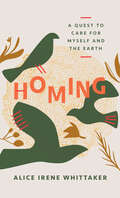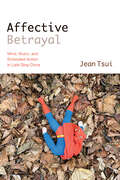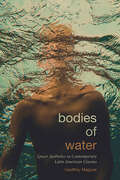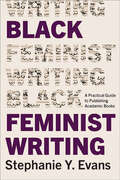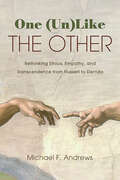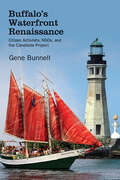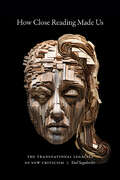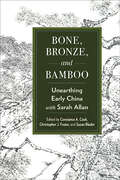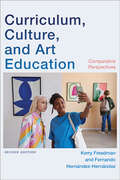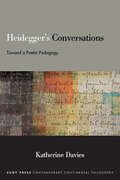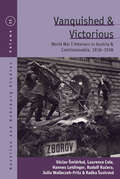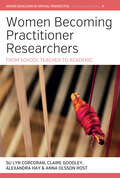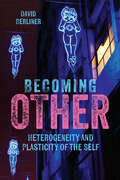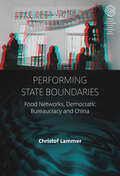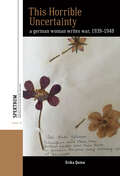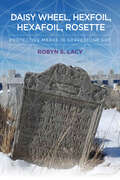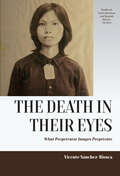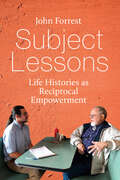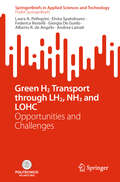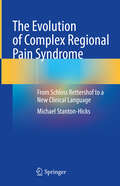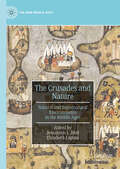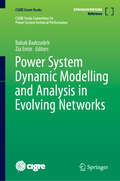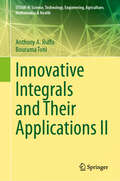- Table View
- List View
Homing: A Quest to Care for Myself and the Earth
by Alice Irene WhittakerA memoir about abandoning an exhausting commuter lifestyle to move to a cabin in the woods, embracing imperfection while cultivating a life of care for self and nature.Alice Irene Whittaker was addicted to productivity, perfectionism, and discipline, making sure that every single moment of the day was accounted for. Then she finds herself as a new mother, commuting four hours a day into the city, exhausted by the state of the world, paralyzed by climate guilt and anxiety. Overnight, Alice Irene and her family decide to retreat to a cabin in the woods, in search of a new kind of life. Surrounded by creek, meadow, and forest, Alice Irene begins a new lifelong journey of repairing her fractured relationship with both herself and the natural world. Her quest takes her to meet a renowned economist-rancher in Colorado, to stand at the side of a runway at a sustainable fashion show in Portland, and to witness firsthand rewilding of wolves in Yellowstone. She interviews and learns from dozens of people who are building homes, growing food, making clothes, raising families, and living their lives in regenerative ways. Searching for the spaces between the sorrow of wildfires and the beauty of wildflowers, Homing is a lyrical memoir about moving from a life of despair to a life of care.
State Power and Governance in Early Imperial China: The Collapse of the Qin Empire, 221–207 BCE (SUNY series in Chinese Philosophy and Culture)
by Chun Fung TongState Power and Governance in Early Imperial China delves into the governance and capacity of the state by providing an empirical historical study of the collapse of China's Qin Empire. In contrast to the popular view that the Qin fell suddenly and dramatically, this book argues that the collapse was rooted in persistent structural problems of the empire, including the serious resource shortages experienced by local governments, inefficient communication between administrative units, and social tensions in the new territories. Rather than reducing Qin rulers to heartless villains who refused to adjust their policies and statecraft, this book focuses on the changes that the regime did make to meet these challenges. It reveals the various measures that Qin rulers devised to solve these problems, even if they were ultimately to no avail. The paradox of the Qin Empire seemed to be that, although the regime's policies and reforms could theoretically have strengthened the state's power and improved the governance of the empire, their ramifications simultaneously exacerbated the misfunction of local governments and triggered the military failures that eventually destroyed the empire.
Affective Betrayal: Mind, Music, and Embodied Action in Late Qing China (SUNY series in Chinese Philosophy and Culture)
by Jean TsuiAffective Betrayal uses "affect" as an analytical category to explicate the fragility and fragmentation of Chinese political modernity. In so doing, the book uncovers some of the unresolved moral and philosophical obstacles China encountered in the past, as well as the cultural predicament the country faces at present.At the turn of the twentieth century, China's leading reformer Liang Qichao (1873–1929) presented modern political knowledge in musical and visual representational formats that were designed to stimulate readers' bodily senses. By expanding the reception of textual knowledge from "reading" to "listening" and "visualizing experiences," Liang generated an epistemic shift, and perhaps an all-inclusive internal intellectual, philosophical, and moral transition, alongside China's modern political reform. By tracing the marginalized academic and philosophical positions Liang sought to restore in China's incipient democratic movement, Affective Betrayal examines how his attempts to conjoin Confucian morality and liberal democracy expose hidden anxieties as well as inherent contradictions between these two systems of thought. These conflicts, besides disrupting the stability of China's burgeoning modern political order, explain why the import of modern concepts led to China's continued political impasse, rather than rationality and progress, after the 1911 revolution.
Bodies of Water: Queer Aesthetics in Contemporary Latin American Cinema (SUNY series in Latin American Cinema)
by Geoffrey MaguireRivers, swimming pools, lakes, and oceans: these watery spaces recur with remarkable frequency in recent queer Latin American cinema, urging us to question the intimacies between queerness and the aquatic. Unpredictable and uncontrollable, water reflects a natural fluidity in our sexual desires and orientations; it is both a space and a substance, one in which bodies surrender themselves to the natural forces of currents and flows. As the first book to investigate water's queer cinematic potential, Bodies of Water proposes that we think not only about water but also through it, illuminating new directions for the study of queer world cinema and its evolving aesthetic strategies. Bodies of Water engages critically with theories of cinematic embodiment and recent work in queer theory and the environmental humanities, foregrounding a region of the world historically overlooked in global discussions of queerness. By examining the radical queer epistemologies that emerge at the convergence of body, camera, and water, Bodies of Water ultimately poses a question of both critical and sociopolitical concern: what's so queer about cinematic waters?
Black Feminist Writing: A Practical Guide to Publishing Academic Books
by Stephanie Y. EvansWriting scholarly books is stressful, and academic publishing can be intimidating—especially for women, queer folks, and scholars of color. Black Feminist Writing shows scholars how to prioritize their mental health while completing a book in race and gender studies. Drawing on Black women's writing traditions, as well as her own experience as the author and editor of nine university press books, Stephanie Y. Evans gives scholars tools to sustain the important work of academic writing, particularly in fields routinely under attack by anti-democratic forces. Evans identifies five major areas of stress: personal, professional, publishing-related, public, and political. Each chapter includes targeted discussion questions and tasks to help authors identify their unique stressors, create priorities, get organized, and breathe. Whether working on your first scholarly book or your tenth, this robust, heartfelt guide will help you approach writing as an ongoing practice of learning, creating, and teaching in ways that center wellness and collective self-care.
One: Rethinking Ethics, Empathy, and Transcendence from Husserl to Derrida (SUNY series in Theology and Continental Thought)
by Michael F. AndrewsOne (Un)Like the Other responds to the question, "What are the conditions of possibility that make genuine knowledge of other persons—and, therefore, love—possible?" By providing an original interpretive framework for exploring ethics in relation to empathy and transcendence from multiple perspectives in continental philosophy, empathy is described as a trace of what remains essentially and irreducibly "other" in every act of givenness. The use of the phenomenological method places "Einfühlung theory" in its rich historical context, beginning with Husserl and the early phenomenologists and extending to contemporary issues that explore "otherness" in light of consciousness, gender, embodiment, community, intentionality, emotions, intersubjectivity, values, language, and apophatic discourse. The implications of recasting "empathy" in an interpretive and dialogical model of reciprocity envision new paradigms of understanding ethics as an infinite playing field. No longer subservient to metaphysics and ontology, empathy is described as an act of infinite concern, a "hermeneutics of suspicion" that transcends epistemological theory and ethical command. Drawing on Husserl, Scheler, Stein, Heidegger, Levinas, Derrida, and others, this study presents an examination and expansion of empathy as an encounter with otherness in its most radical and transcendent forms.
Buffalo's Waterfront Renaissance: Citizen Activists, NGOs, and the Canalside Project (Excelsior Editions)
by Gene BunnellThis book tells the remarkable story of howBuffalo's post-industrial waterfront was reclaimed for public use and enjoyment and pays tribute to the many local citizens and nongovernmental organizations that made the city’s waterfront renaissance possible. After years of litigation, public controversy and debate, preservationists and environmentalists ultimately succeeded in persuading the state to abandon its contentious plans for privately developing Buffalo's waterfront. Gene Bunnell, an experienced urban planner, lays out the Buffalo waterfront's long and troubled history, from the torrent of shipping and commercial activity that was unleashed by the opening of the Erie Canal, to the contamination of the Buffalo River due to waterside industries, to how the Outer Harbor—the last portion of the waterfront to be industrially developed—was reshaped and contaminated by filling in low-lying areas with a toxic mix of waste materials. Drawing on interviews and articles, editorials, and op-eds from The Buffalo News, Bunnell provides the reader with a "real-time" sense of how the struggle over the future of Buffalo's waterfront unfolded and the ultimate victory by local activists to secure environmental cleanup, restored natural habitats, and expanded public waterfront access.
How Close Reading Made Us: The Transnational Legacies of New Criticism
by Yael SegalovitzDoes reading shape who we are? What happens to the relationship between reading and subject-formation as methods of interpretation travel globally? Yael Segalovitz probes these questions by tracing the transnational journey of the New Critical practice of close reading from the United States to Brazil and Israel in the mid-twentieth century. Challenging the traditional view of New Criticism as a purely aesthetic project, Segalovitz illustrates its underlying pedagogical objective: to cultivate close readers capable of momentarily suspending subjectivity through focused attention. How Close Reading Made Us shows that close reading, as a technique of the self, exerted a far-reaching influence on international modernist literary production, impacting writers such as Clarice Lispector, Yehuda Amichai, William Faulkner, João Guimarães Rosa, and A. B. Yehoshua. To appreciate close reading's enduring vitality in literary studies and effectively adapt this method to the present, Segalovitz argues, we must comprehend its many legacies beyond the confines of the Anglophone tradition.
Bone, Bronze, and Bamboo: Unearthing Early China with Sarah Allan (SUNY series in Chinese Philosophy and Culture)
by Constance A. Cook; Christopher J. Foster; Susan BladerBone, Bronze, and Bamboo explores the tremendous wealth of newly unearthed artifacts and manuscripts that have been revolutionizing the study of early China. Leading scholars from China and abroad lend their expertise in archaeology, art history, paleography, intellectual history, and many other disciplines to show how these fascinating finds change our understanding of China's past. Organized in a chronological progression from the Shang to Han periods, and treating bone, bronze, and bamboo-strip artifacts in turn, the book treats a wide breadth of topics, from the status of owls in Shang religion to the Zhou court's economic interest in managing salt resources, and from the conceptual evolution of de 德 in Spring and Autumn covenants to the interplay between materiality and text in Han scribal primers. Bone, Bronze, and Bamboo exemplifies the exciting energy and sense of discovery inspired by these sources in recent years, while surveying the latest debates and developments shaping early China as a field.
Curriculum, Culture, and Art Education, Second Edition: Comparative Perspectives
by Kerry Freedman; Fernando Hernández-HernándezA general broadening of content and methods, a renewed emphasis on student interests, and diverse critical perspectives can currently be seen internationally in art curricula. This book explores ways that visual culture in education is helping to move art curricula off their historical foundations and open the field to new ways of teaching, learning, and prefiguring worlds. It highlights critical histories and contemporary stories, showing how cultural milieu influences and is influenced by the various practices that make up the professional field inside and outside of institutional borders. This book shows students how contemporary art educators are responding, revising, and re-creating the field.
Heidegger's Conversations: Toward a Poetic Pedagogy (SUNY series in Contemporary Continental Philosophy)
by Katherine DaviesReading Martin Heidegger's five conversational texts together for the first time, Heidegger's Conversations elaborates not only what Heidegger thought but how he did so by attending to the philosophical possibilities of the genre of these under-studied texts written between 1944 and 1954. Though he wrote little on the topic of teaching and learning explicitly, Katherine Davies shows Heidegger performed an implicit poetic pedagogy in his conversations that remains to be recognized. Heidegger launched an experimental attempt to enact a learning of non-representational, non-metaphysical thinking by cultivating a distinctly collaborative sensitivity to the call of the poetic. Davies illustrates how each conversation emphasizes a particular pedagogical element—non-oppositionality, making mistakes, thinking in community, poetic interpretation, and the dangers of such pedagogy—which together constitute the developmental arc of these texts. Whether Heidegger is revising or reinforcing his own earlier pedagogical practices, Davies argues that attending to the dramatic staging of the conversations offers a distinct vantage point from which to contend with Heidegger's philosophy and politics in the post-war period.
Vanquished and Victorious: World War One Veterans in Austria and Czechoslovakia, 1918-1938 (Austrian and Habsburg Studies #35)
by Laurence Cole Rudolf Kučera Hannes Leidinger Václav ŠmidrkalRecent research has revised earlier views about the role of veterans of World War One in paramilitary formations, radical nationalism and political extremism in inter-war Europe, yet there remain considerable gaps in our understanding of the role they played in the ‘successor states’ of the Habsburg Empire. Vanquished and Victorious provides an innovative comparative investigation of veterans in Austria and Czechoslovakia, two states whose wider political development was of crucial importance to the question of stability in Central Europe after 1918. While differing in terms of how successfully veterans reintegrated into post-war society, this volume shows that both countries incorporated elements of ‘cultures of victory and defeat’.
Women Becoming Practitioner Researchers: From School Teacher to Academic (Higher Education in Critical Perspective: Practices and Policies #8)
by Anna Olsson Rost Su Lyn Corcoran, Claire Goodley, Alexandra HayEarly career researchers (ECRs) in education bring unique histories of professional practice and development into academic research communities. Women Becoming Practitioner Researchers explores autoethnographies of twelve women who were, or still are, schoolteachers in the process of becoming researchers. Using autoethnography to disrupt the established systems that distance researchers from their research, the chapters in this volume are curated to apply theory to this important transition. This theory as method approach provides a foundation for understanding as the authors’ weave threads of identities and experiences into their roles as practitioner researchers.
Unexpected Encounters: Migrants and Tourists in the Mediterranean (Articulating Journeys: Festivals, Memorials, and Homecomings #4)
by Francesco ViettiExploring the intersections between migration and tourism in the Mediterranean, this book is the result of extensive ethnographic research carried out over a decade in the Mediterranean regions. It focuses on three interrelated themes: the experiences of homecoming migrants who visit their country of origin for holidays; the inequalities surrounding the encounters between local people, tourists and migrants in borderlands; and how migration and tourism affect cultural heritage in European cities. The book shows how interconnected mobilities play a crucial role in boosting the global dynamics of cultural, social, economic and political transformation in the Mediterranean.
Becoming Other: Heterogeneity and Plasticity of the Self
by David BerlinerMost of us are conscious of having a single and stable self, but the self is more fragmented and plastic than we care to think. David Berliner explores the captivating world of identity through an array of astonishing experiences. From Napoleon doppelgangers to Philip Roth's alter-ego Nathan Zukerman and Wonder Woman cosplayers to anthropologists going native, he delves into the kaleidoscopic nature of the self and attempts to understand the heterogenous nature of identity. But Becoming Other also discusses a great cultural controversy of our time: who has the right to play at being whom?
Performing State Boundaries: Food Networks, Democratic Bureaucracy and China (EASA Series #51)
by Christof LammerPolarizing images of authoritarian, socialist or culturalist otherness compromise analyses of the Chinese state. Still, such images produce effects beyond academia when they inform performances of the boundaries between state and non-state. This book shows how performative boundary work leads to contrasting judgements that decide about support and access to resources. In an ecological village in Sichuan, citizen participation in food networks and bureaucracy signaled Western liberalism, Maoism or traditional rural culture for different audiences. Attention to the multiplicity of performed state boundaries helps China studies and political anthropology to understand such diverging classifications – and how they sometimes co-exist without causing tensions.
This Horrible Uncertainty: A German Woman Writes War, 1939-1948 (Spektrum: Publications of the German Studies Association #32)
by Erika QuinnThrough the diaries and personal papers of a German woman, Vera Conrad, this book documents her wartime experiences and deepens our understanding of the complex experiences of trauma and grief that National Socialist supporters experienced. Building on scholarship about mourning and widowhood that largely focuses on state policies and public discourses, This Horrible Uncertainty provides an interpretive framework of people’s perceptions of events and their capacity to respond to them. Using a history of emotions approach, Erika Quinn establishes that keeping the diary allowed Conrad to develop different selves in response to her responsibilities, fear, and grief after her husband was declared missing in 1943.
Daisy Wheel, Hexfoil, Hexafoil, Rosette: Protective Marks in Gravestone Art
by Robyn S. LacyThe use of protective symbols, also known as apotropaic marks, are often part of folk magic traditions, appearing in homes, churches, on personal items, and even graves, across Europe, Australia, and North America. The most common and well-known of these marks is the hexfoil, otherwise known as the daisy wheel, witch hex, or rosette. Hexfoils have a history of use for personal protection and were carved both intentionally or graffitied into church pews and walls, bed frames, doors, and gravestones. This research sheds light on the use of this historic symbol to protect the bodies and souls of the deceased, across several thousand years and multiple countries.
The Death in their Eyes: What Perpetrator Images Perpetrate (Studies in Latin American and Spanish History #12)
by Vicente Sánchez-BioscaImages that embody the point of view of the perpetrators of violent crimes, or their accomplices, force us to look at the pain of victims through the eyes of those who caused it. Accompanied by over sixty visuals of historically infamous violence, The Death in their Eyes goes beyond the visible aspects of images to reveal what has been left outside of the frame. Covering human abuse and humiliation at Abu Ghraib, the Auschwitz Album, religious desecration during the Spanish Civil War, an unfinished Nazi propaganda film made at the Warsaw Ghetto in the spring of 1942, and detainees at the S-21 torture center in Cambodia under the Khmer Rouge, this volume proposes a rigorous new methodology for analyzing perpetrator images, in photography and film, that continue to be used and re-appropriated in today’s media. Content warning: This book contains images of victims of murder and torture which are essential to the author’s analysis.
Subject Lessons: Life Histories as Reciprocal Empowerment
by John ForrestLife histories are a class of oral data distinct from memoirs, autobiography, and conventional history in multiple ways. It is a way to lay out the felt experience of events in people’s everyday lives and not simply the statement of historical facts. As narrated pieces, life histories possess the unique voice of the individuals. Collecting data through life histories enables the interviewer-interviewee to develop a special bond that has the capacity to empower both in different ways. Subject Lessons examines the use of and value in using one’s life history as research within the social sciences.
Green H2 Transport through LH2, NH3 and LOHC: Opportunities and Challenges (SpringerBriefs in Applied Sciences and Technology)
by Laura A. Pellegrini Elvira Spatolisano Federica Restelli Giorgia De Guido Alberto R. de Angelis Andrea LainatiThis book explores the opportunities and challenges of hydrogen transport through different carriers (i.e., liquefied hydrogen, ammonia, toluene, and dibenzyltoluene). Each value chain analyzed includes: renewable H2 conversion to the carrier, storage of the hydrogenated carrier, its seaborne transport, reconversion of the carrier to produce H2 and hydrogen distribution. The conversion and reconversion processes are the cost drivers of the whole value chain. These stages are investigated through an in-depth techno-economic assessment, to highlight the critical issues and the need for further investigation (low TRL). The alternatives are examined considering: different H2 applications (industrial and mobility sector); different costs of utilities (present and future scenarios); and different distances from the loading to the unloading terminal. All these scenarios are discussed and compared by means of the levelized cost method, to understand which is the most cost-effective choice for each case study. As a result, H2 application to the industrial sector shows the lowest costs, with ammonia being the best alternative for transporting and storing hydrogen in this case. Liquefied hydrogen is the most expensive H2 carrier for the industrial application, as a consequence of the high liquefaction costs while holding promises for the mobility sector.
The Evolution of Complex Regional Pain Syndrome: From Schloss Rettershof to a New Clinical Language
by Michael Stanton-HicksLong before any written accounts of what has come to be described as Complex Regional Pain Syndrome (CRPS), this book entails a record that began in the department of Anesthesiology headed by Dr. John Bonica who during the Pacific arena of World War II came to manage thousands of wounded servicemen many of whom suffered from this complicated clinical entity often long after their original wounds had healed. Divided into two sections, the first provides a detailed chronology of the research and establishment of diagnostic criteria for CRPS. The second section provides an overview of how CRPS is evaluated and treated, along with the research that serves as its foundations.
The Crusades and Nature: Natural and Supernatural Environments in the Middle Ages (The New Middle Ages)
by Elizabeth Lapina Jessalynn L. BirdThe Crusades and Nature: Natural and Supernatural Environments in the Middle Ages explores the intersection of crusader studies and studies of nature. The volume addresses encounters with, responses to and representations of a broad variety of phenomena: celestial objects and events; familiar and unfamiliar fauna and flora; seascapes and landscapes; the elements and the seasons; etc. It introduces readers to crusaders’ actual, but also largely or entirely imaginary encounters with natural phenomena, as well as literary references to nature in crusader sources more generally (such as, for example, animal metaphors). Finally, this project investigates the relationships between the natural and the supernatural and between nature and human-made environments. The volume will define “crusades” broadly, to include not only crusades to the East, but also crusades to frontier regions such as the Baltic and Iberian peninsula and extends to representations of crusades and nature in later medieval and early modern sources.
Power System Dynamic Modelling and Analysis in Evolving Networks (CIGRE Green Books)
by Babak Badrzadeh Zia EminThis Green Book is an essential resource for power system engineers seeking comprehensive information on contemporary power system dynamic modelling and analysis. With today's rapid adoption of inverter-based resources and the resulting changes in power system dynamics, this book compares conventional power systems with evolving power systems characterized by high shares of grid-connected and distributed inverter-based resources. It covers dynamic phenomena, analysis methods, simulation tools and enablers required for secure and reliable system planning and operation. Starting with an overview of power system studies and associated analysis tools, the book provides modelling requirements for various power system components, including existing and emerging technologies. It includes practical examples from real-world power systems worldwide that act as step-by-step study guides for practising engineers and provides knowledge to apply in their day-to-day tasks. Additionally, the book emphasizes the importance of power system model acceptance testing and validation, providing practical examples of various testing methods. Written with practising power system engineers in mind, this book minimizes the use of advanced mathematics. However, relevant sources for those interested in learning more about mathematical concepts are provided. Overall, this book is an invaluable resource for power system engineers navigating contemporary power systems. Readers who would like to comment on any of the published books or identify errors to the editorial team please contact: cigregreenbooks@springer.com.
Innovative Integrals and Their Applications II (STEAM-H: Science, Technology, Engineering, Agriculture, Mathematics & Health)
by Bourama Toni Anthony A. RuffaIn its second installment, Innovative Integrals and Their Applications II explores multidimensional integral identities, unveiling powerful techniques for attacking otherwise intractable integrals, thus demanding ingenuity and novel approaches. This volume focuses on novel approaches for evaluating definite integrals, with the aid of tools such as Mathematica as a means of obtaining useful results. Building upon the previous methodologies, this volume introduces additional concepts such as interchanging the order of integration, permutation symmetry, and the use of pairs of Laplace transforms and Fourier transforms, offering readers a comprehensive array of integral identities. The content further elucidates the techniques of permutation symmetry and extends the multivariate substitution approach to integrals with finite limits of integration. These insights culminate in a collection of integral identities involving gamma functions, incomplete beta functions, Bessel functions, polylogarithms, and the Meijer G-function. Additionally, readers will encounter applications of error functions, inverse error functions, hypergeometric functions, the Lambert W-function, elliptic integrals, Jacobi elliptic functions, and the Riemann zeta function, among many others, with a focus on their relevance in various scientific disciplines and cutting-edge technologies. Each chapter in this volume concludes with many interesting exercises for the reader to practice. A key tenet is that such approaches work best when applied to integrals having certain characteristics as a starting point. Most integrals, if used as a starting point, lead to no result at all, or lead to a known result. However, there is a special class of integrals (i.e., innovative integrals), which, if used as a starting point for such approaches, lead to new and useful results, and can also enable the reader to generate other new results that do not appear in the book. The intended readership includes science, technology, engineering, and mathematics (STEM) undergraduates and graduates, as well as STEM researchers and the community of engineers, scientists, and physicists; most of these potential readers have experienced the importance and/or the applications of integration from finding areas, volumes, lengths, and velocities to more advanced applications. The pedagogical approach of the exposition empowers students to comprehend and efficiently wield multidimensional integrals from their foundations, fostering a deeper understanding of advanced mathematical concepts.
